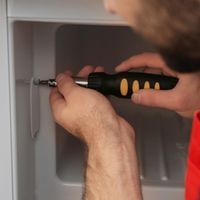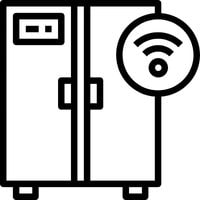Frigidaire refrigerator not cooling. Of all the home appliances, the refrigerator is probably one of our most frequently used.
We rely on our refrigerator to keep food cool, so much so that any cooling issue can have us considering replacing it entirely.
But before chucking it out, is there anything you can do if your Frigidaire refrigerator isn’t getting cold enough? Try these troubleshooting tips when you find your Frigidaire refrigerator not cooling properly to fix the problem yourself.
Frigidaire refrigerator not cooling
Frigidaire refrigerators not cooling may have a dirty or damaged door seal, allowing warm air to enter.
Test by removing the refrigerator from the wall and visually checking if there is any dirt or torn areas that are preventing the seal from sealing properly.
Power supply issue
To ensure you are getting the maximum amount of cold blast from your freezer, make sure to plug it into a 3-prong outlet that uses a 115-Volt, 60-Hz., AC-only 15- or 20-amp fused, grounded electrical supply.
It’s recommended that your refrigerator be connected to a separate circuit serving only your refrigerator. Don’t use an extension cord or an outlet that can be turned off by a switch.
Check to make sure the outlet is working by plugging in a lamp or other small appliance.
Refrigerator temperature needs to be adjusted
If your Frigidaire Freezer is too warm, try checking the temperature settings to see if they’re set correctly.
If you’re having problems with ice production, we offer ice maker troubleshooting tips that recommend verifying the temperature settings in your freezer.
What temperature should my freezer be set at for the freshest ice and coldest cooling? For optimum cooling and fresher ice, it’s recommended most freezers be set between 0-10℉.
However, please check the temperature setting on your Freezer so you can further adjust accordingly if necessary.
Refrigerator storage capacity exceeded
Keeping too many refrigerated items in your refrigerator at once can blow a fuse, making the entire appliance stop working. Cold air funnels into the freezer through vents; they can’t blow cold air if they’re blocked by warm food.
Also, crowding the fridge makes it hard for cool air to circulate between items. Don’t overload the fridge or place warm food near vents.
A ¾ full fridge helps maintain its temperature and allows cool air to reach all of its contents without mixing with warm pockets of food.
The refrigerator door doesn’t seal properly
in most refrigerators; the door’s perimeter is sealed with rubber to provide an airtight seal when the door is shut. As a result, cold air is kept inside, and warm air is kept outside.
It is also possible that there are cracks or holes in the entrance of the refrigerator, which can let warm air in, thus affecting your inventory.
In general, there are different kinds of seals on different models of refrigerators; however, getting a professional to do it is often the better option than trying DIY fixes such as cleaning it yourself.
Dirty condenser coils
If the refrigerator is not maintaining the proper temperature, check and see if there is any debris blocking the condenser coils.
If there’s a lot of dirt and dust buildup on the condenser coils, that doesn’t help dissipate the heat as intended. This then causes your product to work very hard as opposed to working efficiently as you would hope it to.
Catch those dust bunnies before they catch back up with you! If ever in doubt, give them a quick clean.
Defective Start Relay
To determine if the start relay is defective, use a multimeter to observe if there’s continuity between its sockets. If there is no continuity, replace the start relay.
You can also check whether the start relay has any burnt parts by smelling it if there are burnt parts, you need to replace them with new ones immediately.
Faulty Condenser Fan Motor
In order for refrigerators to work properly, they need a condenser fan motor that will draw air through the refrigerator’s cooling coils, then send it through the compressor before delivering it back into the refrigerator area.
If the condenser fan motor is not working, a technician must check its blade for any obstructions and make sure it spins freely on an axle.
If either of these checks does not detect a problem with the motor’s spinning action, a multimeter or some other form of electricity-detecting device needs to be used to test for continuity between two of the wires inside of this part.
If there isn’t enough current running through this section of wires, then an entirely new condenser fan motor needs to be installed in place of the broken one.
defective Thermistor
The thermistor inside the refrigerator is responsible for detecting the temperature so that the unit can cool accordingly.
If the thermistor fails, the compressor and condenser fan may not run when called upon to do so. When this happens, your unit will likely not be cooled sufficiently.
Main Control Board issue
The main control board is the brain of all electronic appliances and devices. The main control board rarely goes bad, even if it displays an error code.
First, test all of the other components before replacing the main control board. If none of the other components are defective, replace the main control board.
Frigidaire refrigerator not cooling
Related Guides
